Ever since I began my fishkeeping journey, I’ve always tried to retain the sense of novelty by digging around the various corners of the internet for new sorts of fish.

As I rummaged about it, I kept being surprised by the various types of African cichlid species that I found.
Some were calm by nature and had modest space requirements, while others needed more real estate simply because of their size.
Even though each species was unique in its own way, all of them were equally colorful and pretty.
In the following list, you’ll find 10 different types of African Cichlids that will add a splash of colors to your tank.
Top 10 Varieties of African Cichlids for a Colorful Tank
After staring at my tank trying to find out what I was missing, it hit me.
I needed a splash of color, but it couldn’t be just any fish, I knew I wanted an African Cichlid to join the family.
African Cichlids are a great fish to include in your fish community, so to make this process easier for you, I’ve made a list of the ten species that got my attention during my research for this.
These are the top 10 most colorful types of African Cichlids:
1. Brown Zebra Cichlid – Neolamprologus Similis
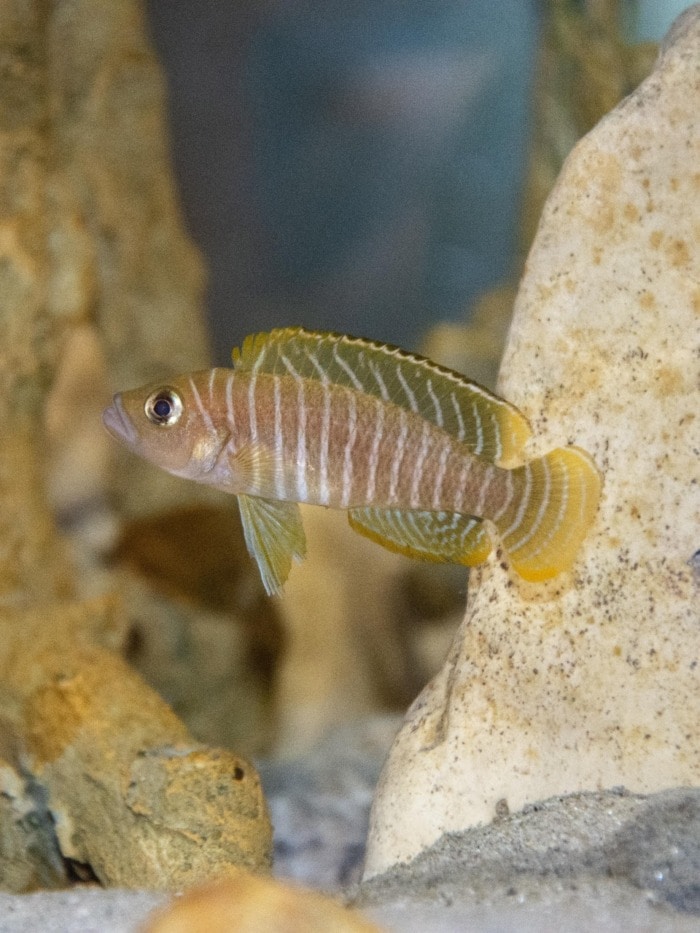
- Maximum adult size: 2 in (5 cm)
- Recommended tank size: 10-15 gallons
- Key traits: Territorial, they live in shells
The lightly colored striped Brown Zebra Cichlid may be small at only 2 inches (5 cm) in size, but it’s filled with a feisty personality that can easily keep you entertained.
As you can probably tell from the common name of Neolamprologus Similis, it has light-colored, almost white stripes that cover its entire body.
These African Cichlids have multiple color variations that include red, black, and white as well.
Brown Zebra Cichlids are snail shell-dwellers that are fairly shy, but that doesn’t mean they won’t put up a fight against anyone that decides to get close to the territory they’ve claimed.
They don’t take up a lot of space, so a 10-15 gallon tank should be enough to keep a pair happy and minimize fights.
Just keep in mind, the Brown Zebra Cichlids will not only defend their shelled territory from other fish, but they will also defend it from you, so watch your fingers if you decide to reach into the tank.
2. Brevis Shelldweller – Neolamprologus Brevis
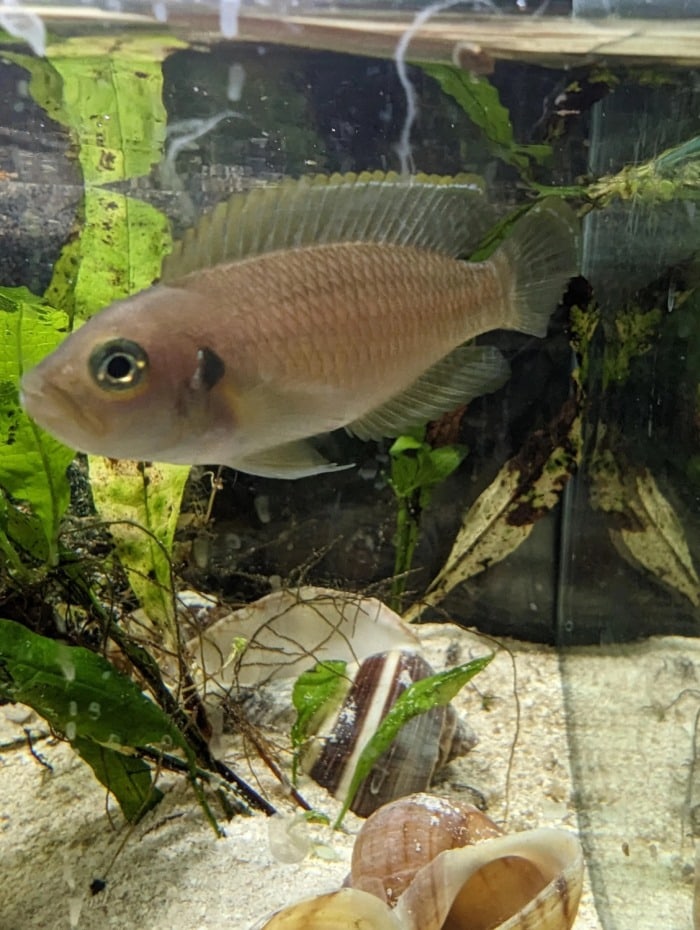
- Maximum adult size: 2.1 in (5.3 cm)
- Recommended tank size: 10-15 gallons
- Key traits: They are small and overall peaceful and they like to live in shells
The Brevis Shell Dweller or Neolamprologus Brevis is a sandy-colored fish that only grows to be about 2.1 inches (5.3 cm) at its adult size.
One cool feature about this fish is that it likes to spend time in empty snail shells, thus explaining the name.
To keep the Brevis Shell Dweller happy, include some deep sandy substrate in their aquarium so that they can bury their claimed snail shells.
These common cichlids are pretty small, so they don’t need a large tank, one at about 10 to 15 gallons will be good for them. If you have some experience with them and know how to provide them with an adequate setup, keeping Brevis Shell Dwellers in a 5-gallon tank becomes an option.
These African Cichlids are pretty peaceful for the most part, but they can get a little aggressive when there are too many males in the enclosure.
Make sure to have more females than males in your tank to avoid conflict.
Brevis Shell Dwellers aren’t the most colorful fish on this list, but they are a great option for an interesting aquarium setup nonetheless.
Author’s note: Make sure to have an excess of empty snail shells at the bottom of the tank so that there are multiple options for your fish to choose from, which will keep competition low.
3. Canary Cichlid – Neolamprologus sexfasciatus
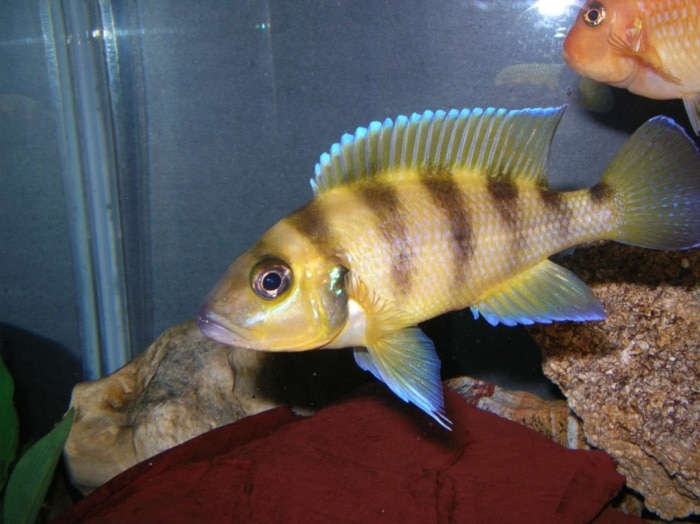
- Maximum adult size: 5.9 in (14.99 cm)
- Recommended tank size: 50 gallons
- Key traits: Aggressive, solitary, yellow with dark striped bands on their body
Despite its sweet-sounding name, the Canary Cichlid does not play well with members of its species nor does it like the company of other types of fish.
Canary Cichlids prefer plenty of space to swim around and a sandy/rocky substrate at the bottom, similar to what they would have in their natural habitat.
The yellow and black abrasive nature of Neolamprologus sexfasciatus makes it difficult for beginner aquarists, so it is not recommended for someone just starting their aquarium journey.
Canary Cichlids grow to about 5.9 inches (14.99 cm) and require at least a 50-gallon tank to be satisfied in their environment because of their confrontational behavior.
Accurately named, this fish is yellow and has 6 distinct bands that go down the sides of its body.
Although they are solitary by nature, the Canary Cichlids may do well in a singular pair when put with a member of the opposite sex, but this doesn’t always work, so pair them with caution.
4. Blue dolphin Cichlid – Cyrtocara moorii
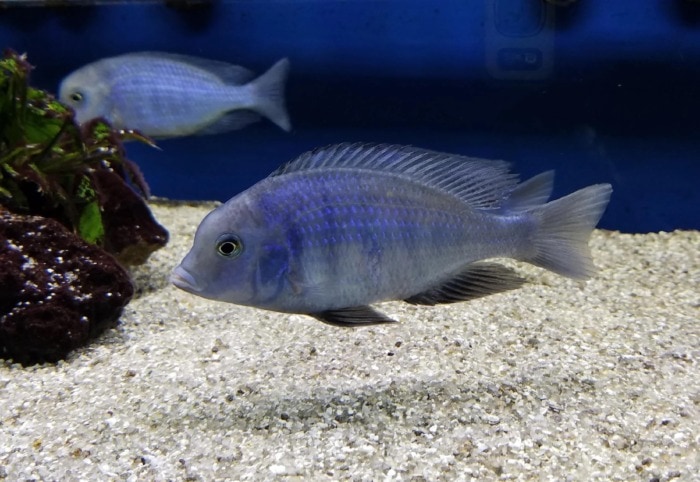
- Maximum adult size: 10 in (25.4 cm)
- Recommended tank size: 125+ gallons
- Key traits: Peaceful nature, a bluish hue, and a humped head
If you’re looking for a calmer cichlid to include in your community tank, the Blue Dolphin Cichlid is a top contender. To easily identify this fish, look for a blue/purple-ish color and a bump on the top of its head that gets bigger as it matures.
Cyrtocara moorii have a pretty decent body length at 10 inches (25.4 cm) when adults, so they need a tank that’s going to match their needs.
They require an aquarium of about 125 or more gallons of water to thrive, so I wouldn’t recommend this cichlid species to anyone that doesn’t have the space to properly care for them.
Also, Blue Dolphin Cichlids are generally peaceful, but the males can get aggressive if they do not have enough female counterparts.
Keep a ratio of one male to 3 females to avoid any unnecessary confrontations.
5. Tangerine Cichlid – Haplochromis nyererei
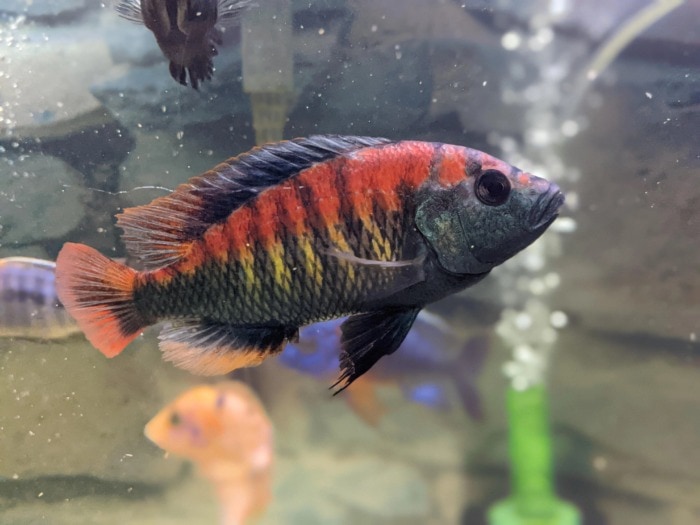
- Maximum adult size: 3 inches (7.6 cm)
- Recommended tank size: 75 gallons
- Key traits: Aggressive if cornered or crowded, colorful
The temperament of Tangerine Cichids varies depending on the space they have in their tank, so make sure they’ll inhabit a 75-gallon or a larger tank.
They need their own territory and plenty of room to move about the tank without being threatened by other fish swimming too close by.
It’s also important to recreate the Tangerine Cichlids’ natural habitat as best as you can. Add plenty of cichlid-friendly rocks and plants to enrich their environment and create hiding places for them.
The tiny Tangerine Cichlids will grow to only 3 inches (7.62 cm) in length, but their vibrant colors make them hard to miss.
This species of cichlid has striking red, blue, yellow, black, and orange colors on them.
So if you’re looking for a fish you can admire all day, the Tangerine Cichlid, or Haplochromis nyererei, is a wonderful choice.
Author’s note: Keep in mind that, as with all other cichlids on this list, feeding yours high-quality foods is essential to help them display their best colors.
6. Black Spotted Cichlid – Haplochromis aeneocolor
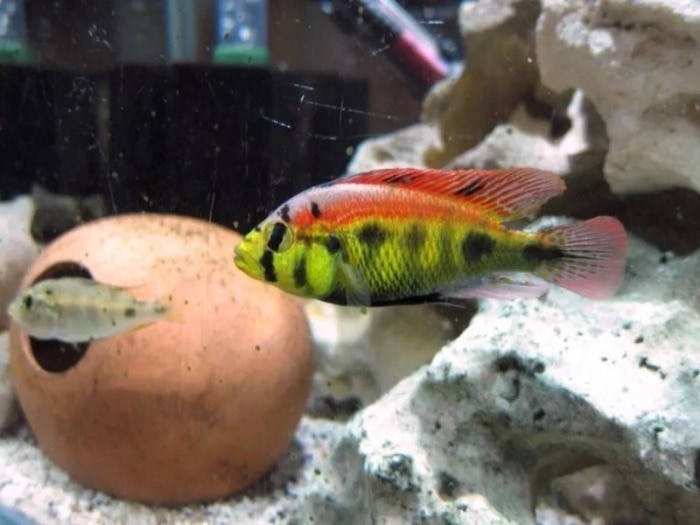
- Maximum adult size: 4 in (10 cm)
- Recommended tank size: 55 gallons
- Key traits: Aggressive, colorful with black spots
Haplochromis aeneocolor or the Black Spotted Cichlid is native to lake Victoria and similar to the previously mentioned cichlids in terms of its aggressive nature.
Black Spotted Cichlids like their own space and will defend it if they feel any other fish has encroached on their territory.
When fully grown, you can expect your Black Spotted Cichlid to reach about 4 inches (10 cm) in size.
They aren’t large fish, but their territorial nature requires that they have a lot of space to swim around.
A 55-gallon tank is a good starting place to keep Black Spotted Cichlids but bigger is more often than not a better option.
These kinds of cichlids are very colorful with shades of red, green, yellow, grey, and black found on their scales.
They have black spots randomly within their vibrant colors, thus explaining the name “Black Spotted Cichlid”.
Although this species of fish is beautiful to look at, its hostile nature might make it difficult for beginners to manage.
7. Blue Striped Cichlid – Pseudotropheus demasoni
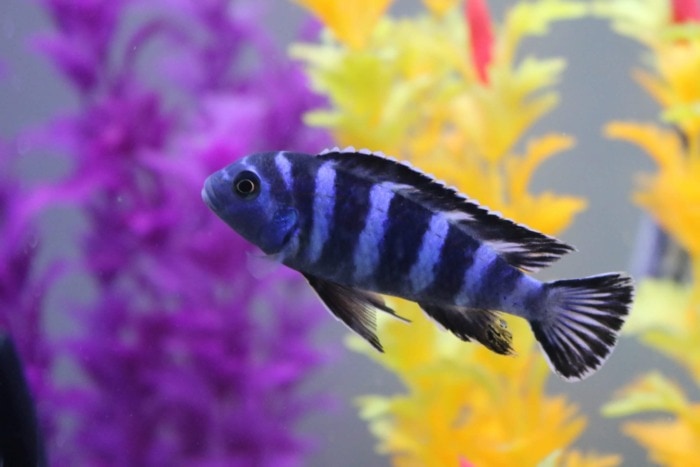
- Maximum adult size: 3 in (7.6 cm)
- Recommended tank size: 75 gallons
- Key traits: Aggressive, striking blue color and dark stripes
The Blue-Striped Cichlids have a striking tone of blue and black stripes going down their bodies that make them hard to resist when stocking your new community aquarium. Their bright hues can grab your attention from any part of the tank.
They, like many other cichlids, live in lake Malawi which is located near South Africa.
In their natural habitat, you may find Blue-Striped Cichlids swimming in rocky areas with plenty of caves and hiding places to live in.
They are not the biggest fish on this list, but they still need quite a lot of space in an aquarium.
A tank holding around 75 gallons should be enough to ensure you can comfortably house large groups of Blue-Striped Cichlids.
This fish is aggressive by nature, so it’s not recommended to house them with fish other than cichlids.
The Blue-Striped Cichlid (Pseudotropheus demasoni), also needs to be housed in groups of 12, one male to 11 females, to avoid aggression and incidents during mating.
8. Dwarf Mbuna – Pseudotropheus Saulosi
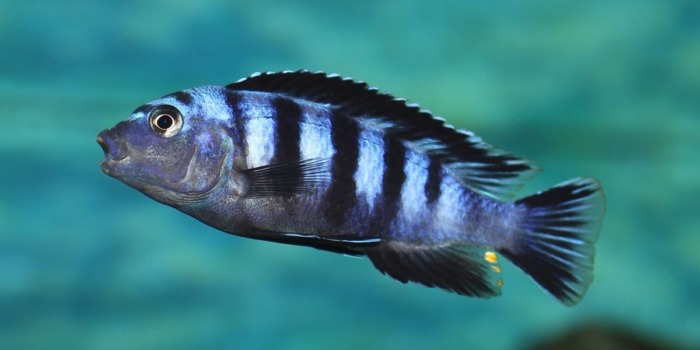
- Maximum adult size: 3.5 in (8 cm)
- Recommended tank size: 30-55 gallons
- Key traits: Slightly aggressive, males are dark blue with stripes and females are yellow
These vibrantly colored fish are another great addition to your aquarium, despite their slightly abrasive nature. The Dwarf Mbuna, also known as Pseudotropheus Saulosi, is an excellent choice for anyone who is just starting with fishkeeping.
Their tank size can be between 30 and 55 gallons for the best results, which isn’t overwhelming for people that may not have the most experience with owning an aquarium.
The size of their tank might be a little confusing when you consider their small size of 3.5 inches (8 cm), but they need to be kept in larger groups to avoid aggression from males.
The Dwarf Mbuna relies on safety in numbers, but it’s best to keep only one male and make the rest female to avoid issues stemming from the competition.
It is easy to tell the male Dwarf Mbuna from the females due to their distinct color variations.
For proper identification, keep in mind that the males will be dark blue with stripes on their bodies while the females will be a vibrant neon yellow. I’ve also included the Dwarf Mbuna in my resource post about the best dwarf cichlids to keep.
9. Emperor Cichlid – Aulonocara nyassae
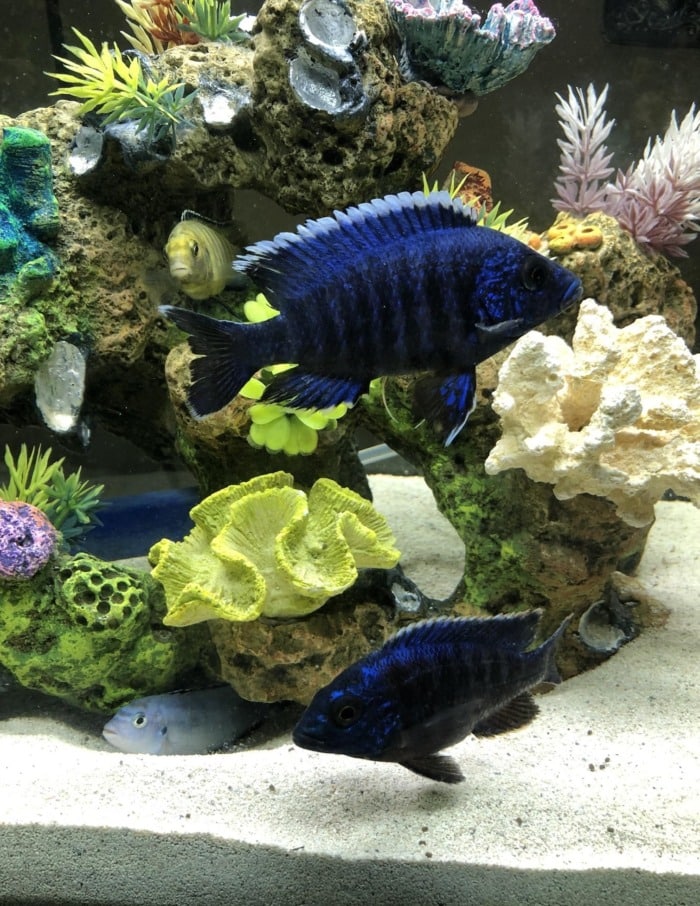
- Maximum adult size: 6 in (15 cm)
- Recommended tank size: 55 gallons
- Key traits: Fairly peaceful, electric blue (but they can come in a variety of colors)
One look at the Emperor Cichlid and it’s easy to understand why they are such a sought-after and popular option in the fish-keeping world.
Emperor Cichlids don’t take up a lot of space at only 6 inches (15.24 cm) fully grown, so you only need a tank size of about 55 gallons or so to keep them.
As is the case with most of the lake Malawi cichlids, these fish prefer sand or gravel-based substrate with plenty of rocks to hide and play in.
Aulonocara nyassae aren’t the most social fish, so they rely on a place to hide when things get stressful for them.
They also prefer to not live with their own breed.
The peaceful nature and gorgeous blue color make the Emperor Cichlid a great choice for anyone looking to expand their community aquarium.
10. Blue Neon Peacock – Aulonocara Steveni
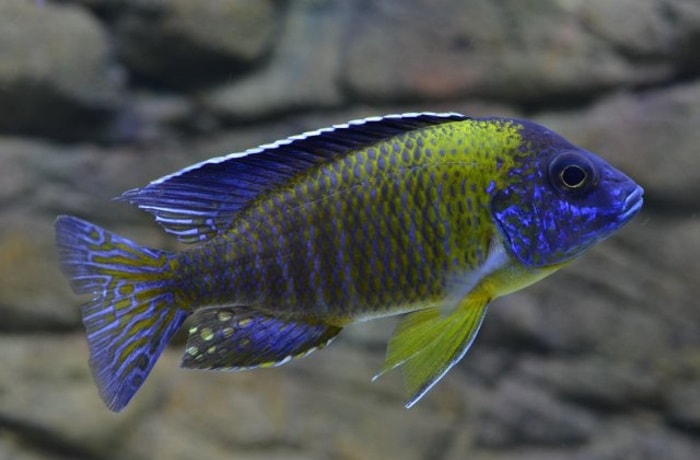
- Maximum adult size: 6 in (15.24 cm)
- Recommended tank size: 55 gallons
- Key traits: Semi-aggressive, blue and yellow colors
The rare Blue Neon Peacock cichlid has certainly earned its name with its brightly colored neon blue and yellow markings, similar to the animal it was named after.
Despite the semi-aggressive nature of this fish, Aulonacara Stevini is a fairly popular choice amongst aquarists who are on the look for cool-looking freshwater fish. Compared to other cichlids on this list, the Blue Neon Peacock is fairly calm, but it will still fight other aggressive males during breeding time.
To avoid as many altercations as possible, try to have a tank of at least 55 gallons to ensure that all inhabitants have enough space of their own.
The Blue Neon Peacock cichlid is best housed with other calm cichlids like the Black Peacock or the Azureus cichlid.
This species is not the biggest or smallest fish on my list, but it’s pretty average at around 6 inches (15.24 cm) in size.
Blue Neon Peacock cichlids prefer a sandy substrate with rocks they can hide in. Do your best to recreate their natural environment as accurately as possible.
How many African Cichlids can you keep together?
African cichlids do best when housed together, but they will get aggressive if the tank becomes overcrowded.
Try not to put more than 15 in a 55-gallon tank and that’s considering each specimen’s specific needs.
If you have a bigger tank you can include more, but keep in mind the different sizes, species, and temperaments of the cichlids you decide to put together.
The best approach here would be to individually research each species you’d like to keep and follow its specific care needs. There absolutely are certain species that can live together peaceably due to their calmer nature.
If you are not sure what species can go in the same tank, do some reading to find the cichlids that are most compatible with one another.
Generally speaking, cichlids do best when housed with other members of a similar demeanor.
My Final Words
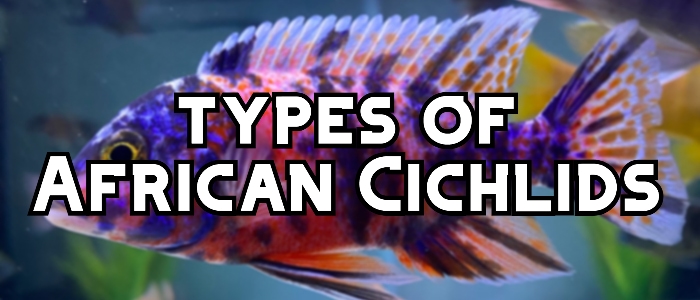
Despite all the wonderful African cichlids mentioned on this list, some species are more compatible with you and your tank than others.
It’s important to find what fits best for you and your aquarium.
You should always prioritize your ability to take care of a cichlid over how much you like its colors.

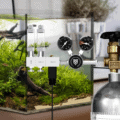
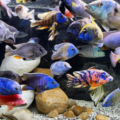
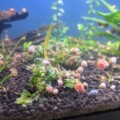
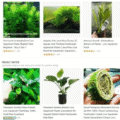
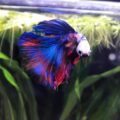
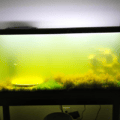
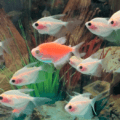
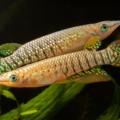
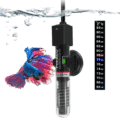

7 thoughts on “10 Types of Colorful African Cichlids”